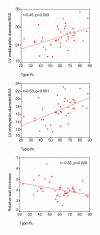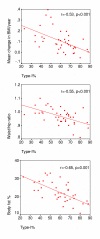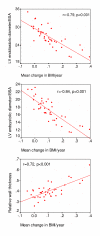Muscle fiber-type distribution predicts weight gain and unfavorable left ventricular geometry: a 19 year follow-up study
- PMID: 16403232
- PMCID: PMC1382267
- DOI: 10.1186/1471-2261-6-2
Muscle fiber-type distribution predicts weight gain and unfavorable left ventricular geometry: a 19 year follow-up study
Abstract
Background: Skeletal muscle consists of type-I (slow-twitch) and type-II (fast-twitch) fibers, with proportions highly variable between individuals and mostly determined by genetic factors. Cross-sectional studies have associated low percentage of type-I fibers (type-I%) with many cardiovascular risk factors.
Methods: We investigated whether baseline type-I% predicts left ventricular (LV) structure and function at 19-year follow-up, and if so, which are the strongest mediating factors. At baseline in 1984 muscle fiber-type distribution (by actomyosin ATPase staining) was studied in 63 healthy men (aged 32-58 years). The follow-up in 2003 included echocardiography, measurement of obesity related variables, physical activity and blood pressure.
Results: In the 40 men not using cardiovascular drugs at follow-up, low type-I% predicted higher heart rate, blood pressure, and LV fractional shortening suggesting increased sympathetic tone. Low type-I% predicted smaller LV chamber diameters (P < or = 0.009) and greater relative wall thickness (P = 0.034) without increase in LV mass (concentric remodeling). This was explained by the association of type-I% with obesity related variables. Type-I% was an independent predictor of follow-up body fat percentage, waist/hip ratio, weight gain in adulthood, and physical activity (in all P < or = 0.001). After including these risk factors in the regression models, weight gain was the strongest predictor of LV geometry explaining 64% of the variation in LV end-diastolic diameter, 72% in end-systolic diameter, and 53% in relative wall thickness.
Conclusion: Low type-I% predicts obesity and weight gain especially in the mid-abdomen, and consequently unfavourable LV geometry indicating increased cardiovascular risk.
Figures



Similar articles
-
Muscle fiber-type distribution as a predictor of blood pressure: a 19-year follow-up study.Hypertension. 2005 May;45(5):1019-23. doi: 10.1161/01.HYP.0000165023.09921.34. Epub 2005 Apr 18. Hypertension. 2005. PMID: 15837823
-
Changes in Body Weight and Composition Are Associated With Changes in Left Ventricular Geometry and Function in the General Population: SHIP (Study of Health in Pomerania).Circ Cardiovasc Imaging. 2017 Mar;10(3):e005544. doi: 10.1161/CIRCIMAGING.116.005544. Circ Cardiovasc Imaging. 2017. PMID: 28298284
-
Left ventricular mass and systolic dysfunction in essential hypertension.J Hum Hypertens. 2002 Feb;16(2):117-22. doi: 10.1038/sj.jhh.1001302. J Hum Hypertens. 2002. PMID: 11850769
-
Clinical aspects of left ventricular diastolic function assessed by Doppler echocardiography following acute myocardial infarction.Dan Med Bull. 2001 Nov;48(4):199-210. Dan Med Bull. 2001. PMID: 11767125 Review.
-
Modulation of endothelial cell phenotype by physical activity: impact on obesity-related endothelial dysfunction.Am J Physiol Heart Circ Physiol. 2015 Jul 1;309(1):H1-8. doi: 10.1152/ajpheart.00177.2015. Epub 2015 May 1. Am J Physiol Heart Circ Physiol. 2015. PMID: 25934096 Free PMC article. Review.
Cited by
-
Trait-specific tracking and determinants of body composition: a 7-year follow-up study of pubertal growth in girls.BMC Med. 2009 Jan 26;7:5. doi: 10.1186/1741-7015-7-5. BMC Med. 2009. PMID: 19171028 Free PMC article.
-
Muscle fiber phenotype: a culprit of abnormal metabolism and function in skeletal muscle of humans with obesity.Am J Physiol Endocrinol Metab. 2023 Dec 1;325(6):E723-E733. doi: 10.1152/ajpendo.00190.2023. Epub 2023 Oct 25. Am J Physiol Endocrinol Metab. 2023. PMID: 37877797 Free PMC article. Review.
-
Epidemiology and Cardiovascular Benefits of Physical Activity and Exercise.Circ Res. 2025 Jul 7;137(2):120-138. doi: 10.1161/CIRCRESAHA.125.325526. Epub 2025 Jul 3. Circ Res. 2025. PMID: 40608856 Review.
-
Single nuclei profiling identifies cell specific markers of skeletal muscle aging, frailty, and senescence.Aging (Albany NY). 2022 Dec 13;14(23):9393-9422. doi: 10.18632/aging.204435. Epub 2022 Dec 13. Aging (Albany NY). 2022. PMID: 36516485 Free PMC article.
-
Fine-mapping of genes determining extrafusal fiber properties in murine soleus muscle.Physiol Genomics. 2017 Mar 1;49(3):141-150. doi: 10.1152/physiolgenomics.00092.2016. Epub 2017 Jan 13. Physiol Genomics. 2017. PMID: 28087756 Free PMC article.
References
-
- Saltin B, Gollnick PD. Skeletal muscle adaptability, significance for metabolism and performance. In: Peachey LD, editor. Handbook of Physiology. Baltimore, United States: Williams and Wilkins; 1983. pp. 555–631.
-
- Simoneau JA, Bouchard C. Genetic determinism of fiber type proportion in human skeletal muscle. FASEB J. 1995;9:1091–1095. - PubMed
-
- Costill DL, Daniels J, Evans W, Finh W, Krahenbuhl G, Saltin B. Skeletal muscle enzymes and fibre composition in male and female track athletes. J Appl Physiol. 1976;90:149–154. - PubMed
Publication types
MeSH terms
LinkOut - more resources
Full Text Sources
Medical

